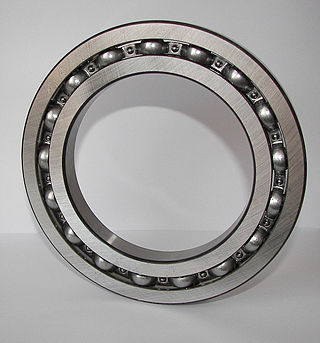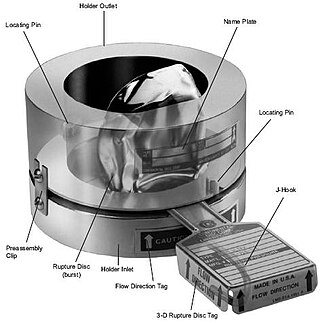
Flexography is a form of printing process which utilizes a flexible relief plate. It is essentially a modern version of letterpress, evolved with high speed rotary functionality, which can be used for printing on almost any type of substrate, including plastic, metallic films, cellophane, and paper. It is widely used for printing on the non-porous substrates required for various types of food packaging.

A mine roller or mine trawl is a demining device mounted on a tank or armoured personnel carrier, designed to detonate anti-tank mines. It allows engineers to clear a lane through a minefield which is protected by enemy fire.

A bearing is a machine element that constrains relative motion to only the desired motion and reduces friction between moving parts. The design of the bearing may, for example, provide for free linear movement of the moving part or for free rotation around a fixed axis; or, it may prevent a motion by controlling the vectors of normal forces that bear on the moving parts. Most bearings facilitate the desired motion by minimizing friction. Bearings are classified broadly according to the type of operation, the motions allowed, or the directions of the loads (forces) applied to the parts.

A perforation is a small hole in a thin material or web. There is usually more than one perforation in an organized fashion, where all of the holes collectively are called a perforation. The process of creating perforations is called perforating, which involves removing bits of the workpiece with a tool. Old-fashioned lick-and-stick postage stamps are perforated. When a tool makes small cuts in the material it is called 'rouletting', because that tool often resembles a roulette wheel, with blades around the edge. Raffle tickets are a good example of rouletting.

Stiffness is the extent to which an object resists deformation in response to an applied force.

A compactor is a machine or mechanism used to reduce the size of material such as waste material or bio mass through compaction. A trash compactor is often used by business and public places like hospitals to reduce the volume of trash they produce. A baler-wrapper compactor is often used for making compact and wrapped bales in order to improve logistics.

Tracker action is a term used in reference to pipe organs and steam calliopes to indicate a mechanical linkage between keys or pedals pressed by the organist and the valve that allows air to flow into pipe(s) of the corresponding note. This is in contrast to "direct electric action" and "electro-pneumatic action", which connect the key to the valve through an electrical link or an electrically assisted pneumatic system respectively, or "tubular-pneumatic action" which utilizes a change of pressure within lead tubing which connects the key to the valve pneumatic.

A garage door is a large door to allow egress for a garage that opens either manually or by an electric motor. Garage doors are frequently large enough to accommodate automobiles and other vehicles. The size of the garage doors varies. Small garage doors may be made in a single panel that tilts up and back across the garage ceiling. More oversized doors are usually made in several jointed panels that roll up on tracks across the garage ceiling or into a roll above the doorway. The operating mechanism is usually spring-loaded or counterbalanced to offset door's weight and reduce the human or motor effort required to operate the door. Less commonly, some garage doors slide or swing horizontally. Doors are made of wood, metal, or fiberglass, and may be insulated to prevent heat loss.

A lint roller or lint remover is a roll of one-sided adhesive paper on a cardboard or plastic barrel that is mounted on a central spindle, with an attached handle. The device facilitates the removal of lint or other small fibers from most materials such as clothing, upholstery and linen. Once expended, the roll can typically be replaced with a "refill" roll. Invented in 1956 by Nicholas McKay, Sr., his most well-known product was the Lint Pic-Up, the world's first lint roller.

Roller hockey, rink hockey or quad hockey is a team sport played on roller skates. It is a quad-skate team sport where two teams face-off against one another, trying to drive a hard ball with their sticks into the opposing teams' goalnet. Each team has five players on the rink at a time, four of whom are skaters and one who is the goalkeeper. The ball can only be put in motion by a stick, not the skate, otherwise a foul will be stated. The game has two 25-minute halves, with 15-minute halftime intermission, plus up to two 5-minute golden goal periods to settle ties with the clock stopping when the ball becomes dead. If the tie persists, a penalty shootout will determine the winner. Players – including the goalie – use quad skates, whereas inline skates are used in inline hockey. The sticks are similar to those in bandy and shinty. Excessive contact between players is forbidden in rink hockey, unlike inline hockey.

A chain is a serial assembly of connected pieces, called links, typically made of metal, with an overall character similar to that of a rope in that it is flexible and curved in compression but linear, rigid, and load-bearing in tension. A chain may consist of two or more links. Chains can be classified by their design, which can be dictated by their use:

A rupture disc, also known as a pressure safety disc, burst disc, bursting disc, or burst diaphragm, is a non-reclosing pressure relief safety device that, in most uses, protects a pressure vessel, equipment or system from overpressurization or potentially damaging vacuum conditions.

A rolling pin is a cylindrical food preparation utensil used to shape and flatten dough. Two styles of rolling pin are found: rollers and rods. Roller types consists of a thick cylinder with small handles at each end; rod type rolling pins are usually thin tapered batons. Rolling pins of different styles and materials offer varying advantages, as they are used for different tasks in cooking and baking.

A conveyor system is a common piece of mechanical handling equipment that moves materials from one location to another. Conveyors are especially useful in applications involving the transport of heavy or bulky materials. Conveyor systems allow quick and efficient transport for a wide variety of materials, which make them very popular in the material handling and packaging industries. They also have popular consumer applications, as they are often found in supermarkets and airports, constituting the final leg of item/ bag delivery to customers. Many kinds of conveying systems are available and are used according to the various needs of different industries. There are chain conveyors as well. Chain conveyors consist of enclosed tracks, I-Beam, towline, power & free, and hand pushed trolleys.

A tape transport is the collection of parts of a magnetic tape player or recorder that move the tape and play or record it. Transport parts include the head, capstan, pinch roller, tape pins, and tape guide. The tape transport as a whole is called the transport mechanism.
Sinclair & Carroll v. Interchemical, 325 U.S. 327 (1945), is a United States Supreme Court decision that held a patent invalid for lack of inventiveness.

The yaw bearing is the most crucial and cost intensive component of a yaw system found on modern horizontal axis wind turbines. The yaw bearing must cope with enormous static and dynamic loads and moments during the wind turbine operation, and provide smooth rotation characteristics for the orientation of the nacelle under all weather conditions. It has also to be corrosion and wear resistant and extremely long lasting. It should last for the service life of the wind turbine) while being cost effective.
Roller Electrospinning system a method for producing nanofibres was developed by Jirsak et al.. This method is known under the name Nanospider from Elmarco Company in Liberec. Roller electrospinning is the unique method which has been used in industry to produce nanofibers continuously. Nanospider consists of rotating roller to spin fibers directly from the polymer solution. This roller spinning electrode partially immersed in the tank with the polymer solution. A grounded collector electrode is placed at the top of the spinner. A nonwoven backing material moves along the collector electrode which makes the production of the nanofibre layer a continuous process. Many Taylor cones are simultaneously formed on the surface of the rotating spinning electrode, which makes the technology highly productive.














